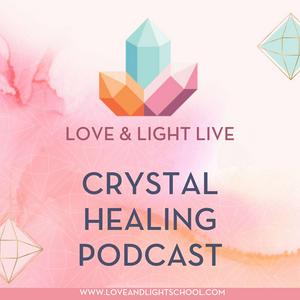210 episodes

Crystals for New Beginnings in the New Year
11/12/2025 | 19 mins.
The new year is a common time to make big changes and set the stage for transformation and a fresh start. Most of us have grandiose plans at first, but quickly slip back into old habits. So how can you be sure to stick with your plans and stay on track with your goals in the new year? Try working with these top crystals for new beginnings! Crystals work great along with your intentions for helping you reach your goals. For example, Rhodonite is a fantastic crystal for new beginnings. To start a new routine in the new year, simply reach for a piece of Rhodonite and hold it in your hands. Close your eyes and think about exactly what you’d like to do differently in the new year. Visualize it in great detail - is it a new wellness routine, a commitment to read a book per week, or quitting a habit? See it as clearly as possible, as if you can see it playing like a movie in your mind’s eye. Once you’ve been able to visualize this new routine, hold the crystal over your heart for a moment to show gratitude to the stone. Your stone has now been imprinted, or programmed, with the information from your visualization. Once you’ve programmed your stone, simply carry it with you, in your purse, pocket, or handbag. Any time you feel yourself begin to stray from your new routine, just reach for your stone for a bit of support and a reminder of that good feeling you had during your visualization, as well as a reminder of what you're working toward and why it's important to you. This will help ensure that your good intentions for creating new beginnings keep their momentum the whole year through. Since you’ll be carrying your stone throughout the day, you’ll need to be sure to cleanse it frequently. One of the simplest methods of cleansing is to pass it through the smoke of burning herbs. Try rosemary, mugwort, or lavender. A great alternative method to smoke-cleansing your stones is to ring a bell or sound a chime near your crystal. Sound is a powerful cleanser of energy and is quick, simple, and convenient. For more ideas, see this article on other common crystal cleansing methods. And while you're cleansing your stones, you may wish to cleanse your space while you're at it. By allowing stagnant energy to linger in your environment, you’re inadvertently telling the Universe that you’re fine with anything in your life that feels stuck. Clearing this energy out of your space tells the Universe that you’re ready for new energy that's more aligned with your current vision and goals. Click Here to Check Out Our Classic Blog Post on Using Selenite & Black Tourmaline for Cleansing & Protecting Your Space so that you can welcome some new energy in the New Year! Something important to remember is that new beginnings don't just magically happen. Lasting change typically requires our effort and focus. Many of us remember to do simple things like routine energy cleansing. But when it comes down to energetic self-care, it’s easy to fall short. Quick and easy healing exercises are ideal (because you’ll actually DO them), but are they effective? Let me put it this way, it's better to do little exercises more frequently because they are quick and easy than to put off energetic self-care because you don’t feel like you have time. It’s almost always better to be doing something than to do nothing at all – especially when it comes to your energetic well-being. Click Here to Check Out Our Classic Blog Post, “3 Tips for Self-Care with Crystals” and get your New Year’s self-care routine in place now!

Crystals & A Card Spread for Insight at Samhain
22/10/2025 | 29 mins.
Samhain (pronounced the Gaelic way, SAH-win) is celebrated on October 31. This holiday marks the beginning of the dark half of the year here in the Northern Hemisphere and is the perfect time to hold space for ancestor connection, intuition, the thinning of the veil, death, introspection, rebirth, divination, and honoring the dead! It's a day to connect with ancestors and honor those who have passed on. Samhain is also an introspective time that can heighten intuition & divination, and call for meditation on death and rebirth. *If you live in the Southern Hemisphere, you'll be celebrating the festival of Beltane today instead of Samhain to keep with the seasonal cycles. The 3 Best Crystals to work with on and around Samhain are: Black Moonstone - A darkly reflective crystal perfect for promoting intuition and personal insight. Use it wisely when you're ready to ask big questions this month. Sangre Calcite - This deep red calcite is a powerful fire element symbol that makes it a great helper for vitality and motivation in the colder months. Howlite - This stone is associated with the world of dreams and that which lies "beyond the veil," making it a good complement for connection with ancestors and the spirit realm. More Samhain Crystals: Black Obsidian Bloodstone Black Moonstone Black Onyx Carnelian Hagstone Howlite Jet Red Garnet Red Sangre Calcite Shungite Smoky Quartz Snowflake Obsidian Set Up Your Samhain Ritual Altar! Samhain Symbols Ale or Mead Pumpkin Skull Besom or Broom Beans Cauldron Bat Key Squash Pomegranate Nuts Apples & Cider Bones Samhain Herbs: Angelica Catnip Cinnamon Mandrake Mugwort Rose Hips Rosemary Vervain Wormwood Samhain is Also Known As/Related To: Halloween All Hallows Eve Calan Graeaf Ancestor Night Third Harvest Final Harvest Day of the Dead Witch's New Year Sauin Bonfire Night All Saints' Day All Souls' Day Celtic New Year Tap into the ancient wisdom of your crystals and harness the liminal energy of the final harvest with our Samhain Kit! On this day when the veil is thin and we exist in liminal space, it’s the perfect time to hold space for ancestor connection, intuition, introspection, rebirth, divination, and honoring the dead. That's why I've created my Samhain Kit – to help you tap into these sacred energies through ritual, divination, meditation and of course, crystal energy. Inside, I'll guide you through how to: Connect with your Ancestors: Learn how to communicate with your ancestors and guides during this time when the veil between worlds is the thinnest. Heighten Your Intuition: Deep dive with your crystals to enhance your intuition and inner guidance, helping you make important life decisions. Experience Powerful Divination: Learn to work with Tarot or oracle Cards with a powerful card spread that will help you gain clarity about what’s in store for you during the coming months as you navigate the dark half of the year. But hurry! My Samhain Kit, along with all of my other Wheel of the Year Celebration Kits, are leaving the shop on Friday, October 31st...and once they're gone, they won't be back! Grab your individual holiday kits (Samhain, Yule, Imbolc etc.) – or purchase all 8 kits for a bundled discount to save 25% – just make sure to do so before they disappear for good! Open yourself up to the messages of illumination at this time of the Fire Festival with a Sacred Samhain Card Spread! This reading will cover 6 aspects of the Final Harvest and shift into the Celtic New Year with highly specific info to help you: Uncover hidden influences that are affecting the events in your life and navigate the thin, mystical spaces Hear messages from the universe specific to your unique spiritual path, intuition, and connection to your ancestors or guides Look into what you need to focus on now on your soul path by gaining insight into what to sow and cultivate now until the light returns Interpreting Card #1 What are you harvesting now from the energy of this past year? This card helps summarize your journey over the past year and what has ripened and is now ready for harvest. Think of all you've been working to grow and create in your life - now is the time to reap the rewards of your efforts and call in the harvest. Interpreting Card #2 What should you sow and cultivate from now until the time when the light returns at Imbolc? Now that you've called in the harvest and completed a cycle, what would you most like to sow the seeds of in this moment? What will serve you best in the coming year? The energy you focus on now will begin to show itself and come back to you in big ways by Imbolc. This card may hold some hints or inspiration on what to do next. Interpreting Card #3 What should you release into the darkness and burn away in the bonfire of your soul? What needs to be released at this time? And what is no longer serving you? What is potentially holding you back from all that you'd like to embody in your life? This card is here to help you recognize and accept the things that are ready to be let go so that you can create space in your life for things that will better serve and support you in the coming year ahead. Interpreting Card #4 Tips for navigating the thin spaces and walking between worlds as a powerful seeker. Samhain is the time of the thinning of the veil - when worlds co-exist and we are able to walk between worlds. What are you seeking right now? What answers have you been searching for? How can you traverse the realm of shadow or the Otherworld while keeping one foot planted firmly in this realm? Interpreting Card #5 Future influences coming in at this time of the turning of the Wheel for the Celtic New Year. This card helps give you insight into any new, fresh energy that's coming into your life during this time of shift and change, What should you be on the lookout for? What may be on the horizon in the coming year? How will this energy affect you as you move forward? Interpreting Card #6 A special message from your ancestors and guides about what you most need to know right now. This final card represents a special message to you from your ancestors of guides. What is it that they would like to communicate with you at this time? What lessons, knowledge, or wisdom are they passing on to you? How may you best heed their words? Because Samhain is such a powerful time for intuition and divination, this is also a great time of year to practice the sacred art of charm casting: In this method of divination, you’ll look at how the charms fall in relation to one another and use their positions and energies to tell a story. Get started with my Samhain Charm Casting Divination Kit! Are you interested in becoming a Certified Crystal Healer? Find out more about the CCH and Advanced Crystal Practitioner Program HERE!

5 Best Crystals for Shadow Work
09/10/2025 | 26 mins.
We’re approaching Samhain - the time of year when the veil is the thinnest and when we move into the dark half of the year. This is a time for withdrawing inward.

Fossil Stone Benefits | 5 Fossils for Crystal Healing
25/9/2025 | 31 mins.
Fossils can be found in nearly every part of the earth, though for some reason, they’re often overlooked by crystal healers who are perhaps lacking the knowledge of all the fossil stone benefits they're missing out on! Perhaps it’s because they often lack the bright colors and glittering, gemmy appearance of many crystals…or perhaps it’s because many crystal workers are unsure of how to work with them. Whatever the reason, it’s time to change that, because incorporating fossils into your crystal work can be deeply rewarding and fulfilling. Though the types of fossils vary, they do share a set of energetic qualities whether they're plant or animal fossils, no matter the mineral type. Individual fossil types have added properties, but all fossils share the following qualities: Common Healing Properties of Fossils: Enhances your connection with nature and its flora and fauna Promotes journey work Facilitates access to your past life memories Enhances communication with your guides Promotes energetic protection Connects you to your ancestors (familial, spiritual, land spirits, etc.) Facilitates grounding Connects you with the energy of the Earth element If you’re interested in developing a relationship with fossils, here are a few of my favorites to explore… Top 5 Fossils for Crystal Healing: #1 - Ammonite Fossils for Crystal Healing Of all the fossils I’ve worked with, Ammonites may be my favorite. They’re a type of cephalopod and their spiral formation evokes a mystical quality that humans have been attracted to for thousands of years. Ammonite fossils are particularly beautiful, and the best are found in Madagascar, England, and Peru. There are various legends and folklore surrounding Ammonite fossils. For example, in England, people referred to Ammonites as “snake stones.” The story behind this is that St. Hilda of Whitby (614-680) prayed for dangerous snakes to be turned to coiled stones, in order to clear the land for a convent (other versions of the lore say St. Hilda turned the snakes to stone to protect the nuns at Whitby Abbey). People believed these “snake stones” to be holy, or at least lucky, and wore them as charms, often with a snake head carved at the end. One genus of ammonites is still known as Hildoceras in the saint’s honor. Properties of Ammonite Fossils: Promotes acceptance Facilitates spiritual journey work and inner work Enhances your connection with Goddess energy Facilitates past life recall Enhances your present moment awareness Facilitates animal communication Assists with receiving guidance from your ancestors Promotes grounding Enhances your connection to Earth energy and nature Aids in recalling your dreams or uncovering past life memories Assists in developing a regular meditation practice Learn more about Ammonite Fossils here. #2 - Belemnite Fossils for Crystal Healing Also known as Thunderstones, Belemnite Fossils are records of a type of squid-like Cephalopod that inhabited the earth from the Triassic period until the Cretaceous period. The “cone” is the most common fossilized portion of the creature, and they’re often found in a sort of bullet- or horn-shaped fossil. Properties of Belemnite Fossils: Aids in decision-making Encourages you to take action Promotes mental clarity Assists with enhancing focus Enhances your connection to your inner voice Facilitates the process of receiving intuitive guidance #3 - Echinoid Fossils for Crystal Healing Echinoids are fossilized Sea Urchins that go by many colloquial names depending on their specific shape. According to Kenneth McNamara, some of the names used to describe them include Thunderstones, Shepherd’s Crowns, Sheep’s Hearts, Bishop’s Knees, Fairy Heads, Fairy Loaves, Chedworth Buns, and Snake’s Eggs. My favorite name for them is “Fairy Loaf” because they really do look like tiny little loaves of bread. In rural England, Echinoid Fossils were used as protective talismans, good luck charms, and magical wards. Properties of Echinoid Fossils: Promotes nurturing and care Facilitates connection with your spirituality Enhances feelings of peace and calming Promote a feeling of lightness when you’re surrounded by heavy or negative energies Facilitates a connection to the energy of the Water Element... Elemental energies shape the world and guide our spiritual practice. By working with fossils, you can access these ancient forces and bring balance, empowerment, and connection into your life. That’s why I created the Fossils for Elemental Magic Course—a beginner-friendly journey into the magic of Earth, Water, Air, Fire, and Spirit. In this course, you’ll explore how fossils act as conduits for elemental energy, empowering you to align with nature’s forces in your rituals, divination, and healing work. Perfect for those seeking to deepen their connection to the natural world, this class offers both practical techniques and spiritual insight. Course Materials Include: A 30-minute video on fossils and elemental magic. Printable slideshow notes with key teachings and techniques. Are you ready to uncover the timeless wisdom of fossils and the elements? Enhance your spiritual practice and unlock elemental energy with the Fossils for Elemental Magic Course! #4 - Fossil Coral for Crystal Healing Fossilized Coral is one of the most diverse fossil types you’ll see. Coming in a variety of shapes, colors, and sizes, these fossils represent a huge group of different organisms. Some of these Corals are millions of years old and are visually fascinating. Some of my personal favorite fossilized Corals are from Michigan in the USA and are known as Petoskey Stones. Properties of Coral Fossils: Promotes vitality and life force energy Facilitates community connection Enhances creativity Encourages love Enhances your connection with nature Promotes feelings of relaxation Assists you in gathering wisdom and drawing on life lessons Instills courage and bravery (especially when facing new and unfamiliar things) Facilitates a connection to your ancestors (familial, spiritual, land spirits, etc.) #5 - Petrified Wood for Crystal Healing Petrified Wood is created when minerals replace the organic molecules in the plant material, capturing its structure in stone (typically Agate or Opal). This fossil is incredibly grounding and helps you with your emotions. Petrified Wood also supports you as you work to create more stability in your life with things like your career and home life to your spiritual practice and your connection with nature. Petrified Wood facilitates the development of persistence and assists you in overcoming obstacles that may be blocking your path. This stone helps you accomplish things by reminding you to take things one step at a time. Properties of Petrified Wood: Enhances grounding and stability Promotes motivation Enhances energetic shielding and protection Facilitates a connection with the Earth Element Promotes creative problem-solving skills Encourages you to take responsibility for your actions Assists with past life work Helps you establish a connection with the nature spirits (especially tree spirits) Facilitates access to ancient wisdom and ancestral guidance Helps you get focused and set a balanced pace for your day Instills patience Facilitates transformation and growth Strengthens feelings of willpower Learn more about Petrified Wood fossil stone benefits here! Home is where the heart—and magic—live. By tapping into the energy of the hearth and the ancient wisdom of fossils, you can infuse your kitchen and home with sacred warmth, protection, and intention. That’s why I created the Fossils for Hearth Magic & Kitchen Witchery Course—a journey into the enchanting traditions of hearth magic and culinary spellcraft. This course teaches you how to turn your kitchen into a magical sanctuary, using fossils as powerful tools to ground and protect your space. From creating a kitchen altar to charging your tools with intention, you’ll learn how to weave magic into everyday life. Course Materials Include: An hour-long video on hearth magic and fossils. Printable slideshow notes with comprehensive class teachings. Highlights: Learn the mystical properties of fossils, transform your cooking into sacred rituals, and create an environment of abundance, warmth, and protection in your home. Want to bring ancient magic and hearth energy into your spiritual and domestic practice? Start your journey with the Fossils for Hearth Magic & Kitchen Witchery Course today! Sources & Further Reading: Cadbury, T. (2021, April). Collecting English Magic: Materiality, Modernity, Museums. https://research-information.bris.ac.uk/ws/portalfiles/portal/277365951/PGR_submission_Cadbury_Tabitha_1155090_combined.pdf McNamara, Kenneth J. The Star-Crossed Stone: The Secret Life, Myths, and History of a Fascinating Fossil. The University of Chicago Press, 2011. National Museums Scotland. (n.d.). Snakestones. https://www.nms.ac.uk/explore-our-collections/stories/natural-sciences/fossil-tales/fossil-tales-menu/snakestones/ Saint Hilda’s College (Oxford). (2020, February 14). St. Hilda’s college: A history. Issuu. https://issuu.com/sthildascollege8/docs/st_hilda_s_history Wikimedia Foundation. (2024a, May 12). Belemnitida. Wikipedia. https://en.wikipedia.org/wiki/Belemnitida Wikimedia Foundation. (2024, May 18). Hilda of Whitby. Wikipedia. https://en.wikipedia.org/wiki/Hilda_of_Whitby Wikimedia Foundation. (2023, November 25). Petoskey Stone. Wikipedia. https://en.wikipedia.org/wiki/Petoskey_stone

10 Best Crystals for Tarot & Oracle Card Readings
11/9/2025 | 30 mins.
I love to use powerful crystals to enhance my other spiritual work - it makes SUCH a difference in my ability to feel physically connected to what I'm doing. If you're looking to enhance your divination practice, the following stones are the 10 best Crystals for Tarot & Oracle Card readings. Crystal oracle cards are one of the quickest and easiest ways to tap into your intuition and call forth just the message you need to get you headed in the right direction. Whether you’re having trouble making a decision, need a little clarity about a situation, or want a little support and encouragement from the universe, oracle cards are a great tool to help you create just the mindset shift you need. You can place these crystals in your sacred space or on your altar, keep them near you, hold them for their energy, or even create a grid or circle of stones around you during the reading. Crystals are such a great support to this work and can really enhance the intuitive process. The 10 best crystals for Tarot & Oracle Card readings: 1. Angelite Angelite has the power to invite your guides and angels in to support you during your reading so that they may provide support, wisdom, or clarity. I also find it to be really soothing, so if I'm feeling a little scattered or anxious, i's a great crystal to have on hand to get you calm and centered before you begin. 2. Amethyst Amethyst, a purple variety of quartz, helps you tap into your intuition and decipher any messages that are coming through during your reading. Have you ever pulled cards for yourself only to feel stumped when it came to actually interpreting them? Try holding an Amethyst crystal while contemplating the meaning of each card, and then of the reading as a whole for more clarity and to see the bigger picture of what this means in your life at this time. 3. Black Tourmaline Black Tourmaline has the ability to keep you safe and protect you from outside energies while you're divining. Because it helps keep you grounded during intense psychic or spiritual work, it makes a great companion stone for any form of divination. 4. Selenite Selenite will ensure that your space is clear and free from stagnant energy or outside energetic clutter, a vital part of any successful reading. When there's too much excess energy, distracted thoughts, etc. focus and interpretation become difficult. But Selenite helps you tune in so that important messages can come through loud and clear. 5. Clear Quartz Clear quartz has the power to amplify your intention of receiving guidance from your cards throughout your reading. I recommend sitting with your stone in your sacred space before beginning your reading, and setting an intention for what you'd most like to receive. Alternatively, you can work with your Clear Quartz stone to help you get more specific about the question you'd like to ask during your reading so that any messages coming through will be focused and on point. 6. Rainbow Fluorite Rainbow fluorite promotes mental clarity so that you can stay focused on what you’re doing and keep your mind from wandering during the reading. It also encourages sharp decision-making, so if you're feeling torn between two different interpretations of a particular card or message, reach for some Rainbow Fluorite to help you feel into which one is most accurate (or if both are needed!). 7. Rose Quartz Gentle but powerful Rose Quartz will remind you to stay heart-centered and compassionate during your reading. Whether you're reading for yourself or for someone else, communicating from a place of compassion is important for seeing the bigger picture and for delivering difficult messages with empathy. 8. Smoky Quartz Smoky quartz will keep you grounded, allowing you to connect to the energy of the earth while you’re tapping into the intuitive realm for your reading. It also has an amazing shielding energy. 9. Labradorite
More Education podcasts
Trending Education podcasts
About Love & Light Live Crystal Healing Podcast
Listen to Love & Light Live Crystal Healing Podcast, 6 Minute English and many other podcasts from around the world with the radio.net app

Get the free radio.net app
- Stations and podcasts to bookmark
- Stream via Wi-Fi or Bluetooth
- Supports Carplay & Android Auto
- Many other app features
Get the free radio.net app
- Stations and podcasts to bookmark
- Stream via Wi-Fi or Bluetooth
- Supports Carplay & Android Auto
- Many other app features


Love & Light Live Crystal Healing Podcast
download the app,
start listening.



















